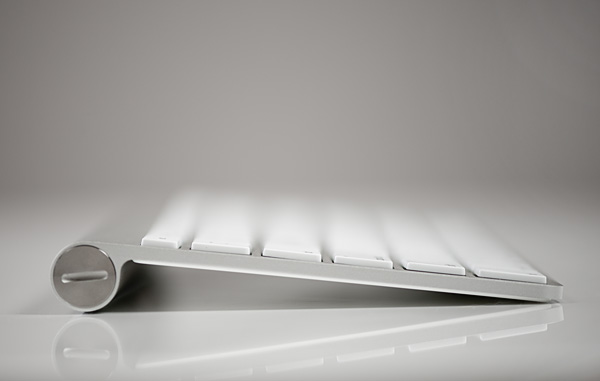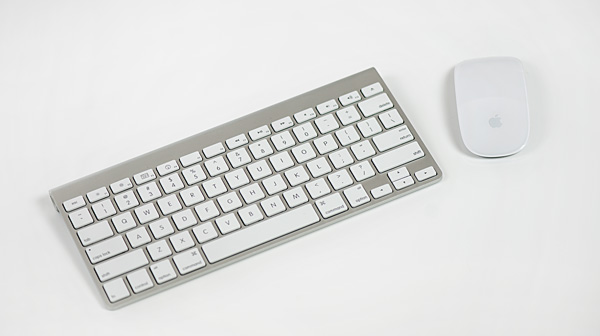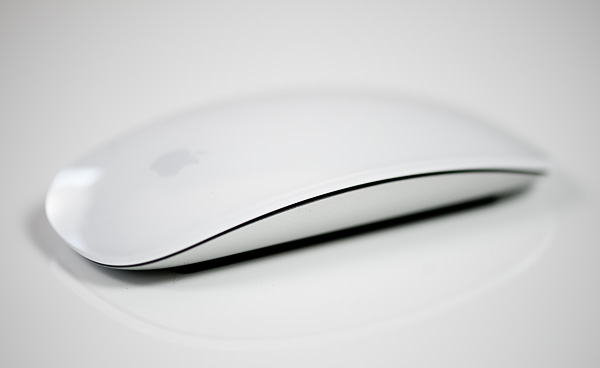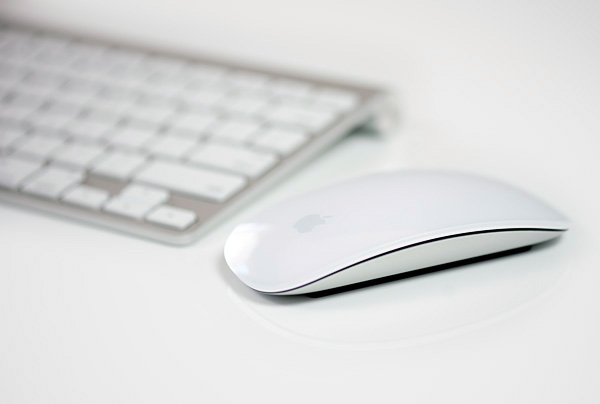The 27-inch Apple iMac Review (2011)
by Anand Lal Shimpi on May 27, 2011 2:30 AM ESTThe Peripherals
I've never been a fan of wireless peripherals - I didn't want more things to charge. Last year I finally broke down and bought a wireless mouse: Microsoft's Wireless Mobile Mouse 4000. I didn't buy it for mobility, I just liked the form factor.
The iMac comes with all wireless peripherals. In fact, if you stick with WiFi for network access, there's only a single cable you need going to the iMac: power. By default you get Apple's Wireless Keyboard and a Magic Mouse.
The Wireless Keyboard is a Bluetooth keyboard that runs off of two AA batteries. It pairs effortlessly with the iMac and I didn't encounter any issues with interference in using it. The keyboard seems to burn through batteries quicker than the mouse, perhaps that's because I type far too much or there's an issue with power management under OS X. After a week of use I'm down to 81% on a fresh pair of batteries (this is my second set).
The keyboard itself is a lot like Apple's standard aluminum keyboard, just wireless and more compact. Apple chopped off the dedicated home/end key island as well as the numeric keypad. Under OS X Cmd + Left/Right Arrow take the place of Home/End for me so part of the sacrifice isn't a problem, but the missing numeric keypad is. I do entirely too much data entry (ahem, benchmarks) to not have a dedicated numeric keypad, and for some reason Apple doesn't offer the Wireless Keyboard with one.
If you don't type tons of numbers every day however, the Wireless Keyboard is really nice. Apple had to stick a function key to the left of the control key, which is a bit bothersome (leave my control/option/cmd row alone) but it's nothing you can't get used to. The footprint is great. I have a giant desk, but I always seem to run out of desk space. The Wireless Keyboard makes it so that I can reclaim a small amount of high value desk area.
Typing feel and keyboard angle are both great - no complaints there. I'm a fan of Apple's keyboards.
Pointing devices designed in Cupertino are another story entirely. I've never liked Apple's mice. It was a big enough problem that when I first tried my Month with a Mac experience I ditched Apple's mouse. There was no way I was going to give the platform a fair shake if I had to use that thing. Since then Apple has at least enabled double clicking - the surface of the Magic Mouse is touch sensitive, click with your right finger and you get a right click. The Magic Mouse has no scroll wheel but drag your finger around on its surface and you get the best scrolling experience on a physical mouse.
The Magic Mouse is also a Bluetooth device that quickly pairs with the iMac. I noticed under Windows there's always a second or two of lag before it recognizes the mouse whereas it's useable as soon as you can see it under OS X.
My complaints about the Magic Mouse are three-fold. As I've mentioned before, the Magic Mouse doesn't have soft rubber feet that glide around on your desk. Instead you get two hard plastic strips that just seem to scrape against all surfaces. Tracking isn't a problem, but it's not a pleasant experience.
The other issue I have is the form factor itself. Microsoft's Wireless Mobile Mouse 4000 is small but it has a nice curve to it that seems to match my hand very well. The Magic Mouse on the other hand doesn't conform to any part of my body. I can lay my hand flat on it but either I'm not conditioned to do that or that's not a very comfortable way to use the mouse for long periods of a time.
Finally there's the clicking noise it makes. Modern mice seem to have a solid but more muted click, whereas the sharp click of the Magic Mouse reminds me of the past decade of Apple mice. I assume that's what Apple was going for, but Apple's market share has grown considerably in the past 10 years - it's ok to let go of some traditions.
Apple does offer the Magic Trackpad as a no-cost option. I have a love/hate relationship with the Magic Trackpad as a pointing device. Scrolling and gestures are great on it, but I prefer a normal mouse for most everything else.
















139 Comments
View All Comments
KoolAidMan1 - Friday, May 27, 2011 - link
"The example given by headbox is a prime example."I can't think of any Mac user who would really try this. I mean, I plug my gaming PC into my 27" iMac as a primary display through the mini-DP port, and I figure I'm in an extreme minority of users. People who plug consoles and BR players and who would need a converter box is be an even tinier number of users.
Don't get me wrong, I'm annoyed that the 2011 iMac has new Target Display Mode requirements, but the limitations of prior models in terms of using set-top boxes (consoles, Blu Ray players) isn't statistically a big enough number to get bent out of shape over, IMHO.
Tros - Friday, May 27, 2011 - link
"How are you going to upgrade the motherboard on a proprietary and overpriced all in one?"This is as much of a criticism on laptops, tablets, smartphones, as all-in-one units. And guess what: That proprietary junk has been of great value to a lot of people, especially if it has an aesthetic appeal.
Penti - Friday, May 27, 2011 - link
While certainly great for what they for probably, it's definitively not the same thing using 23" 1920x1080 120Hz TN-screens with Nvidia 3D Vision as with a good IPS or PVA screen with proper viewing angles and for mostly other uses then gaming. Of course you need your PC to your triple display gaming machine and a strong GPU too.rubaiyat - Wednesday, September 7, 2011 - link
Do you actually use your computer for much besides gaming?I'd rather have an excellent monitor than some dodgy and essentially useless 3D 'feature'.
But that separates consumers in all areas. Those who will see a movie because it has (very loud) surround sound and pseudo 3D with lots of explosions, and those who will see a movie because it actually IS a good movie.
My iMac27 has a brilliantly sharp and accurate 27" 2540x1920 display, that thankfully is not 3D nor runs generally awful Windows grade video.
nafhan - Friday, May 27, 2011 - link
I'm fine spending more on a monitor than a desktop... However, I'll usually go through two or three desktop hardware upgrades before I replace my monitor.fitten - Friday, May 27, 2011 - link
And when the monitor is the majority of the cost of the system, it makes sense to reuse it for future upgrades. Monitor technology seems to evolve slower than the rest of the system so barring some major changes, keeping it for several upgrades won't 'set you behind' any. So, reusing a monitor is an extremely cost efficient technique to keep your computer 'modern'.Spivonious - Friday, May 27, 2011 - link
Exactly. I've had the same NEC (Mitsubishi tube) CRT on my desk for 15 years. The picture is still fantastic and blows any TN-panel LCD out of the water.KoolAidMan1 - Friday, May 27, 2011 - link
Good thing they use the best IPS panels in these things. :)Guspaz - Friday, May 27, 2011 - link
Colour-reproduction wise, perhaps, although that depends on the backlight. In terms of detail and a crisp image, even a cheap TN panel will destroy an old CRT, and IPS panels will match or surpass such a CRT.I'm reminded of a friend of mine, who for years (until perhaps 2-3 years ago) insisted that his old CRT monitor was fine, despite the fact that it was so out of focus that 14 point text was unreadable. He finally relented and upgraded when we proved to him that he was in denial when we realize that the reason he didn't have trouble reading on the monitor was because he increased the text size by 200-300% when he used the monitor. Now, I'm not suggesting that your monitor is out of focus, a good CRT monitor can have excellent sharp detail. But even the best of them comes nowhere close to a half decent LCD.
KoolAidMan1 - Friday, May 27, 2011 - link
Not at all. Sell the iMac and get a better monitor that comes in the next update, it happens every 2-3 years. Resale value is also high.